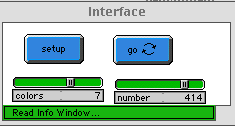
WHAT IS IT? ----------- This model is an example of genetic drift by random selection. It shows that turtles that randomly exchange colors converge on a single color. The model starts with a random distribution of colored agents. Turtles move by wiggling randomly across the screen. When two turtles bump into each other, one turtle loses its color and adopts the color of the other one. After enough turns, a color will gain a slight dominance; by statistical advantage, a dominant color becomes more likely to win the entire grid. However, because the process is random, there will usually be several dominant colors before one color finally wins. The idea, explained in more detail in Dennett's "Darwin's Dangerous Idea", is that trait drifts can occur without any particular purpose or 'selection pressure'. HOW TO USE IT: -------------- The Setup Button intializes the model. The Go Button starts it, and runs continuously. Use the Colors Slider to select the number of colors competing. THINGS TO NOTICE: ---------------- Notice the Graphs of the colors. Often colors that start with a higher initial number fail to win the grid. EXTENDING THE MODEL: -------------------- Try writing the model with a 'randomness' slider that increases the randomness in the turtles? movements. How does this affect the rate at which one color dominates the space? RELATED MODELS: The other models in this set have slightly different mechanisms but also show genetic drift: GD-Local Patches GD-Global Patches GD-Reproducing turtles